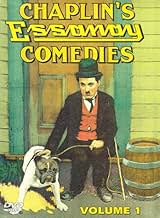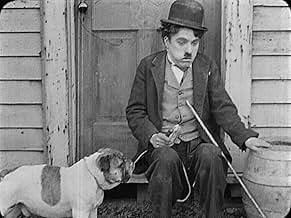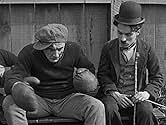Ajouter une intrigue dans votre langueWalking along with his bulldog, Charlie finds a "good luck" horseshoe just as he passes a training camp advertising for a boxing partner "who can take a beating." After watching others lose,... Tout lireWalking along with his bulldog, Charlie finds a "good luck" horseshoe just as he passes a training camp advertising for a boxing partner "who can take a beating." After watching others lose, Charlie puts the horseshoe in his glove and wins. The trainer prepares Charlie to fight t... Tout lireWalking along with his bulldog, Charlie finds a "good luck" horseshoe just as he passes a training camp advertising for a boxing partner "who can take a beating." After watching others lose, Charlie puts the horseshoe in his glove and wins. The trainer prepares Charlie to fight the world champion. A gambler wants Charlie to throw the fight. He and the trainer's daught... Tout lire
- Réalisation
- Scénario
- Casting principal
- Bob Uppercut - Champion
- (non crédité)
- Enthusiastic Fan
- (non crédité)
- Sparring Partner
- (non crédité)
- Second Sparring Partner
- (non crédité)
- …
- First Sparring Partner
- (non crédité)
- …
- Second Stretcher Bearer
- (non crédité)
- Bit Role
- (non crédité)
- Bit Role
- (non crédité)
- Second Cop
- (non crédité)
- Sparring Partner
- (non crédité)
- Trainer's Daughter
- (non crédité)
- Bit Role
- (non crédité)
- Sparring Partner
- (non crédité)
- Ringside Vendor
- (non crédité)
- Spike Dugan
- (non crédité)
- Crooked Gambler
- (non crédité)
Avis à la une
This short is not great, but compared to the previous Essanay shorts, it is a major improvement. That's because this short is more like a mini-movie and is very plot-driven--something ALL great Chaplin shorts have in common. The final boxing sequence is funny but makes no sense--just turn off your brain and enjoy.
By the way,...I like the dog in the film. Dogs like this are cool.
During his apprenticeship at Keystone in 1914 Chaplin learned the rudiments of filmmaking from Mack Sennett, who liked his comedies low and fast. Thus, in his earliest movies Chaplin is concerned only with action and gags, and doesn't seem to care whether the viewer likes his character or not; sometimes he's an out-and-out rotter. But with this new series for the Essanay company Chaplin learned, first, to slow down a little and let things unfold as they may. More importantly, he learned to develop a sympathetic character viewers could care about.
The opening of The Champion shows Charlie sitting on a stoop with his only friend, an endearingly ugly bulldog named Spike, as they eat a meal. Charlie offers a sausage to Spike who, amusingly, chooses to eat only after the sausage has been properly seasoned. It's a charming scene and a leisurely one, and it sets an agreeable tempo. By the time the sequence is over, whether we've seen Charlie before or not, we like this poor guy and his ugly dog, and we're rooting for them. When Charlie decides to try his luck as a boxer he even manages to retain our sympathy when he employs less-than-ethical means to knock out his foe.
Later, we're troubled when Charlie appears to flirt with the idea of accepting a bribe from a crooked gambler, but ultimately the crook gets what he deserves and Charlie is more The Good Guy than ever. This sequence, in some respects, is the funniest in the entire film. Gambler Leo White is hilariously hammy, and Charlie peppers us with gags using every available prop: the paper money he grips in his mouth, the gun that points every which way, and even Leo White's villainous mustache, which Charlie reaches over and twirls one step ahead of the villain.
Everything builds towards the climactic battle. Chaplin fans taking the long view might regard this as a dry run for the big fight in City Lights, made in 1931, but for my money the boxing match in The Champion can hold its own as a great sequence in its own right. In addition to being well staged and beautifully timed, the scene features several notable participants silent film buffs will recognize. Charlie's tubby opponent in the ring is character actor Bud Jamison, at the beginning of a 30-year career supporting just about every prominent comedian of the era. In the stands meanwhile are two prominent players of the day, G. M. "Broncho Billy" Anderson and Ben Turpin. Anderson was among the very first Western stars, and also happened to be a co-founder of the Essanay company, producers of this film. Therefore Anderson was in effect Chaplin's boss, and his cameo (as a highly enthusiastic spectator) can be seen as something of a good-natured inside joke. Ben Turpin, on the other hand, had co-starred with Chaplin in his two previous comedies, but it's said that the two men didn't get along, and they went their separate ways after this point. Turpin is granted a very brief bit as a peanut vendor in the stands during the bout, clambering over spectators before he is bodily thrown out -- out of the stands, out of the film, and, in effect, out of Chaplin's orbit.
In any event, the fight makes for a funny and exciting finale, and it provides Spike the dog with one last moment of screen immortality. (Sadly, the dog was struck and killed by a car shortly after this movie was completed.) For Spike's co-star, The Champion was not only a vast improvement over his earlier work, but the first of many classic comedies.
The set-up of an up-and-coming boxer who fights his way to the top, is then bribed into throwing a fight and has to choose between his integrity and the payoff was an established cliché even back then. This well-known sequence of events allows Chaplin to mess around with stereotypes or subvert conventions. For a start, there is the fact that Charlie is a scrawny little feller, who essentially cheats his way to the championship. Then there's the farcical training routine, which Chaplin cross-cuts with the opponents more serious routine to give it more comedy impact, followed by the tramp's nonchalant seeing-off of Leo White's over-the-top sinister villain.
Throughout Chaplin is showing more confidence in his staging and arrangements. He allows himself to become a more marginal figure in some sequences – for example when Spike Duggan is knocking out one challenger after another, Charlie isn't doing very much, and is off-screen half the time, but it's his reactions to the growing number of defeated men that is funny. The other characters simply act naturally, whereas Chaplin is the originator of all the comedy.
In Chaplin's previous picture, A Night Out, he came dangerously close to becoming a double-act with Essanay's resident comic Ben Turpin. A large part of Chaplin's humour was based on reacting to other comedy characters, so he needed to have his supporting cast of burly bullies and pompous twerps to antagonise. However in the Champion you can see he is being careful not to let any of them have too much screen time. Although Bud Jamison, Leo White and Ernest van Pelt all do a great job, each of them is a walk-on, walk-off character; none of them shares the picture with Charlie. Ben Turpin has a tiny part as a vendor, but even in this one-shot role he manages to violate Chaplin's rule of the tramp being at the comedic centre of attention, stealing the laughs as he scrambles over the crowd to reach a customer. This would be Turpin's last picture with Chaplin.
And now, we finish with the all-important statistic – Number of kicks up the arse: 1 (1 for, 0 against)
Le saviez-vous
- AnecdotesThe film was restored in 2014 through the Chaplin Essanay Project thanks to the financial support of the Niles Essanay Silent Film Museum.
- ConnexionsEdited into Chase Me Charlie (1918)
Meilleurs choix
Détails
- Date de sortie
- Pays d’origine
- Sites officiels
- Langues
- Aussi connu sous le nom de
- Charlie the Champion
- Lieux de tournage
- Société de production
- Voir plus de crédits d'entreprise sur IMDbPro
- Durée31 minutes
- Couleur
- Mixage
- Rapport de forme
- 1.33 : 1
Contribuer à cette page


































